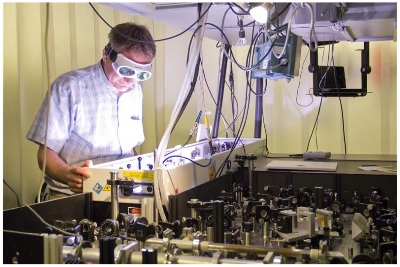A novel method of generating bright laser pulses at x-ray energies was devised in the Photonics Institute labs at the Vienna University of Technology.

Audrius Pugzlys in the Laser Lab at Vienna University of Technology
With a broad energy spectrum, the radiation ensures an extensive range of applications ranging from medicine to materials science. Synchrotrons (particle accelerators) generate such radiation that can now be achieved by a laser laboratory. The new laser technology was published in current issue of ‘Science’.
The photons oscillate in sync within a laser beam, leading to coherent radiation. The labs of Professor Andrius Baltuska’s team such as Photonics Institute, TU Vienna were able to create coherent light that has unique properties. These lights include photons of various energies generating x-ray radiation having high energy and short wavelengths.
Short infrared laser pulses serve as energy sources for this type of radiation. They are applied on noble gas, and release electrons from atoms. The infrared light accelerates these electrons that go back to the atoms, where kinetic energy is converted into x-ray radiation. The long-wave infrared photons are transformed into short-wave x-ray photons. Following the addition of x-ray-waves, a beam of laser-like x-rays will be generated.
The proprietary 100 GW powered infrared laser of the Vienna University of Technology supported this research. The research team from the University of Colorado enabled the production of x-rays in noble gas at high pressure. The research team is currently looking out for ways to minimize the time interval between the laser pulses, anticipating increase in the average intensity of the beam.
Disclaimer: The views expressed here are those of the author expressed in their private capacity and do not necessarily represent the views of AZoM.com Limited T/A AZoNetwork the owner and operator of this website. This disclaimer forms part of the Terms and conditions of use of this website.